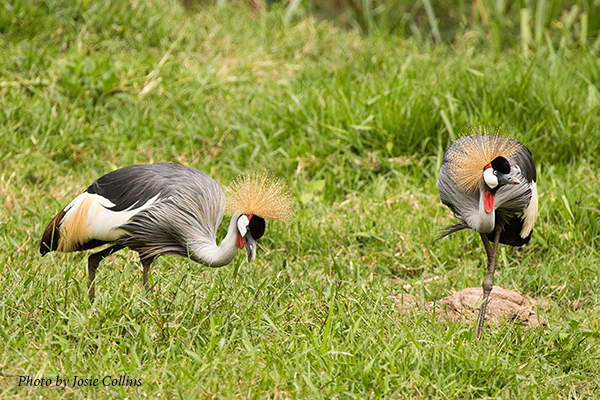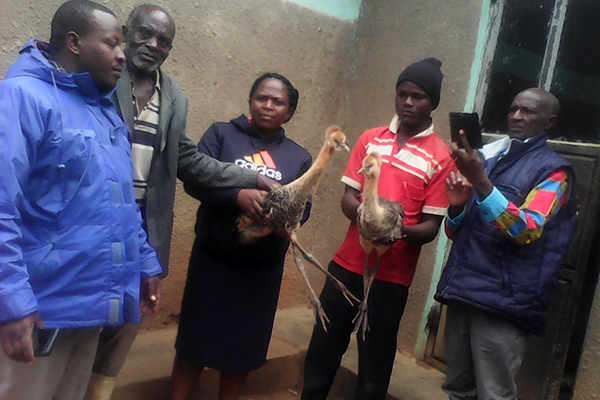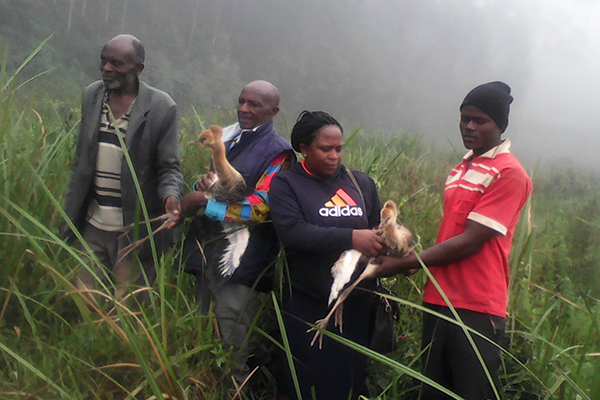
My role in the crane conservation project is that of a patron for the Buranga Primary School “Cranes in the Classroom” program. This program was introduced to us about two years ago by the International Crane Foundation/Endangered Wildlife Trust Uganda Project Coordinator Jimmy Muheebwa. It came in handy when the Grey Crowned Cranes in Kabale were facing incredible persecution through capture for sale across the border into neighboring countries.
My school and I embraced the “Cranes in the Classroom” program and subsequently we have been on the regular look out for any persecuted cranes in the village. On a fateful Saturday, March 9, afternoon, I received a call from our former local council chairperson, Happy Addy. He alerted me to a pair of chicks that had been captured from South Kiruruma by his neighbor John Bosco. Happy informed me that the captor was harboring the crane chicks and wanted to sell them.

What crossed my mind immediately was that Happy should tell Bosco that I would pay for the chicks, as a trap to keep him waiting. This would give me time to seek technical advice and to get to the site to collect photographic evidence. I connected with Jimmy Muheebwa, who by then had traveled for a conference in South Africa. Jimmy advised on the modus operandi for the rescue of the chicks. I then quickly connected with Kagyenda, a crane custodian, and Saturday, a colleague of mine implementing “Cranes in the Classroom” in a sister school. We immediately took a ride to Bosco’s home, who excitedly welcomed us and ushered us into the room where the innocent but now traumatized chicks were spending their nights. He was not opposed to me taking photos of him with the chicks.
 In a conversation that ensued between us, the chick captor, Bosco, told us that he wasn’t worried about whether the chicks would die because he was feeding them well on maize bran, chopped cabbages and sweet potatoes, which cranes eat in the wild. He told us that he was aware of the law that forbids anyone from killing cranes, but there wasn’t a law against keeping cranes. And that in any case, he was keeping them and not killing them.
In a conversation that ensued between us, the chick captor, Bosco, told us that he wasn’t worried about whether the chicks would die because he was feeding them well on maize bran, chopped cabbages and sweet potatoes, which cranes eat in the wild. He told us that he was aware of the law that forbids anyone from killing cranes, but there wasn’t a law against keeping cranes. And that in any case, he was keeping them and not killing them.
I requested that we do a favor to the parents of the chicks and return them to the wetland nearest to where he captured them. Because Bosco and his family members were expecting money, they did not welcome the idea of releasing the chicks. I humbled myself so that we didn’t get into a confrontation, but I told them about what we do in general to save cranes, our national symbol and heritage and a flagship for environmental health. I mentioned the need to have chicks enjoy their full right to parental care and natural feeding atmosphere. I thanked him for laboring to keep the chicks, but I hastened to tell him of the legal implications if he stuck to keeping the cranes at his house or selling them or if they died under his care. My teammates also added their voices to mine, supplementing all that I had said.
Meanwhile, the local council chairperson, whom we had secretly invited, arrived. He shared the same passion as I did, and he reiterated our statements on the legal and even the cultural implications of keeping cranes in captivity. Bosco was by this time trembling thinking he was under arrest. He pleaded that we allow him to deliver the chicks to the wetland of capture. We only allowed him to lead us to the site, but we took control of the situation as Jimmy had advised.

We carried the chicks to the site. We sited from the distance the frustrated and almost bereaved parents of the chicks. As advised by Jimmy, we tickled the chicks so they would make some distress sounds, which attracted the attention of the parents. The chicks made a sharp shrill and “peep” sound which in turn alerted the parents to return the call. They then hovered up in the air, I think, in both surprise and anguish. We dropped the chicks on the ground and, like a plane on a runway, they took off into the wetland. The parents quickly went down, hopefully to “welcome” them back into the fold. They have since then, been seldom seen gracefully feeding under the care of their parents. We are all happy for the mission successfully accomplished.
“With passion, save one, save all.”
Story submitted by Phionah Orishaba, Buranga Primary School Cranes in the Classroom patron
